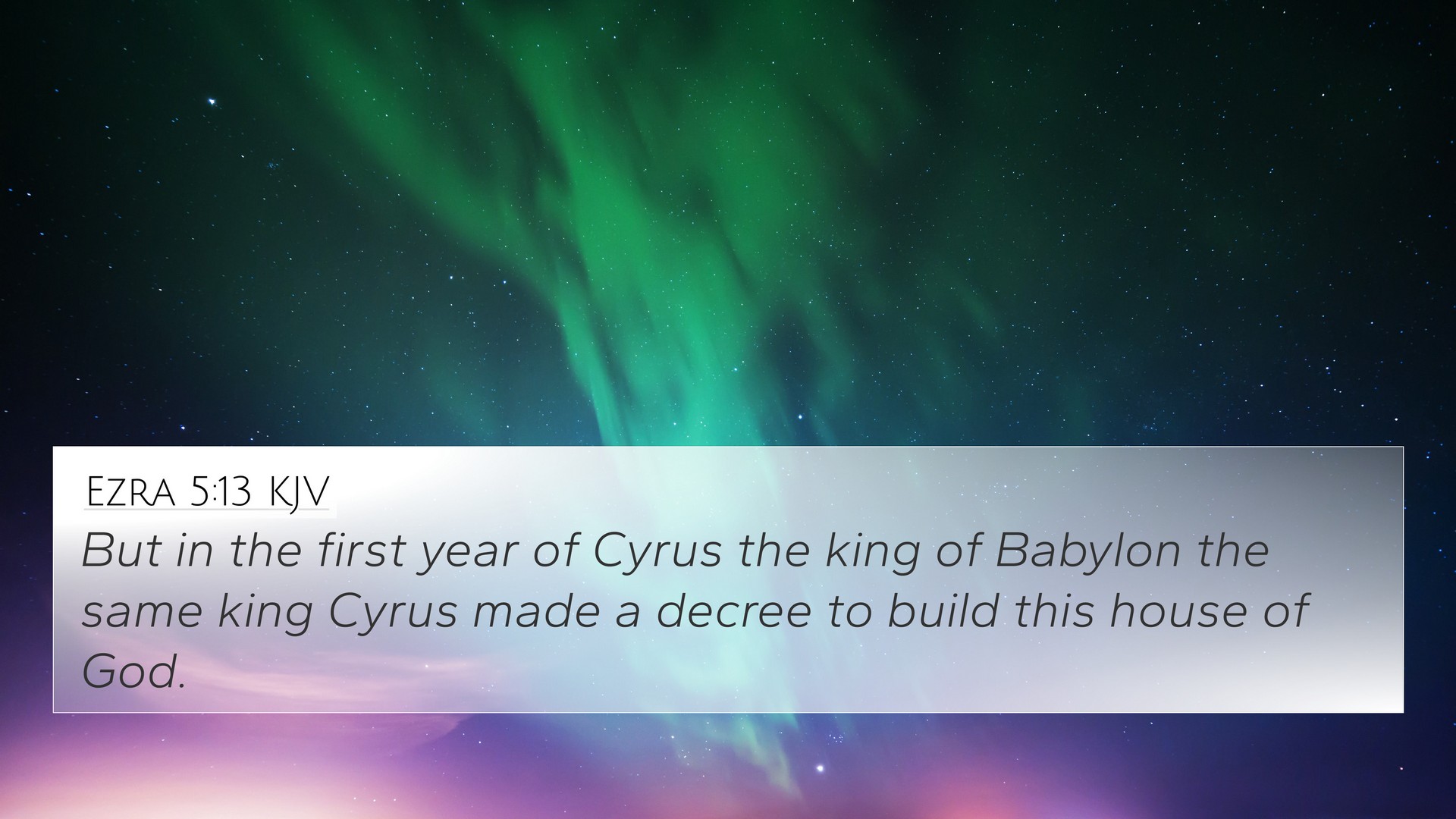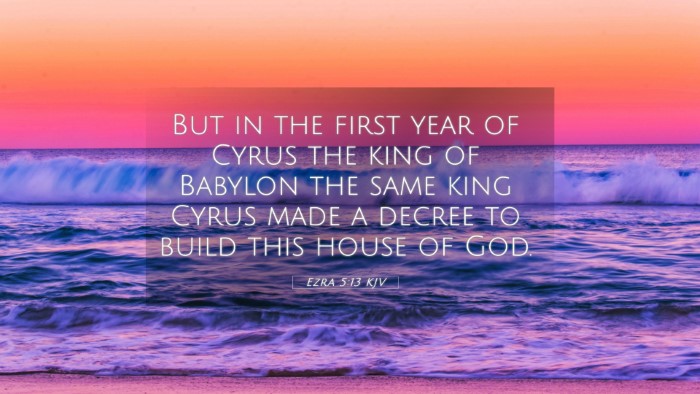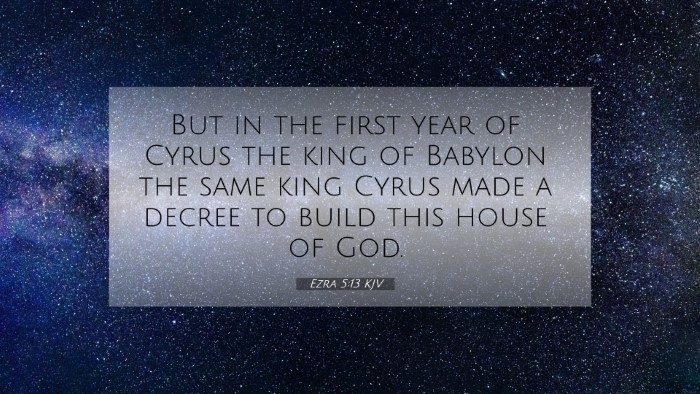Old Testament
Genesis Exodus Leviticus Numbers Deuteronomy Joshua Judges Ruth 1 Samuel 2 Samuel 1 Kings 2 Kings 1 Chronicles 2 Chronicles Ezra Nehemiah Esther Job Psalms Proverbs Ecclesiastes Song of Solomon Isaiah Jeremiah Lamentations Ezekiel Daniel Hosea Joel Amos Obadiah Jonah Micah Nahum Habakkuk Zephaniah Haggai Zechariah MalachiEzra 5:13 Similar Verses
Ezra 5:13 Cross References
But in the first year of Cyrus the king of Babylon the same king Cyrus made a decree to build this house of God.
Uncover the Rich Themes and Topics of This Bible Verse
Listed below are the Bible themes associated with Ezra 5:13. We invite you to explore each theme to gain deeper insights into the Scriptures.
Ezra 5:13 Cross Reference Verses
This section features a detailed cross-reference designed to enrich your understanding of the Scriptures. Below, you will find carefully selected verses that echo the themes and teachings related to Ezra 5:13 KJV. Click on any image to explore detailed analyses of related Bible verses and uncover deeper theological insights.
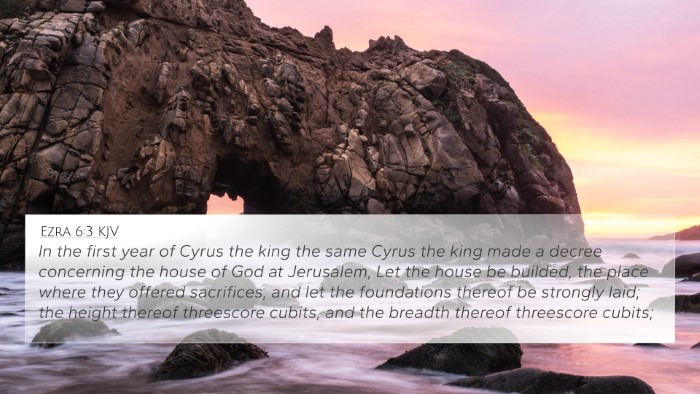
Ezra 6:3 (KJV) »
In the first year of Cyrus the king the same Cyrus the king made a decree concerning the house of God at Jerusalem, Let the house be builded, the place where they offered sacrifices, and let the foundations thereof be strongly laid; the height thereof threescore cubits, and the breadth thereof threescore cubits;
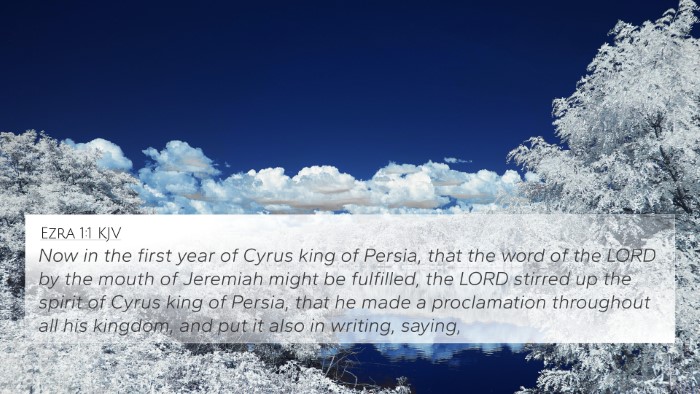
Ezra 1:1 (KJV) »
Now in the first year of Cyrus king of Persia, that the word of the LORD by the mouth of Jeremiah might be fulfilled, the LORD stirred up the spirit of Cyrus king of Persia, that he made a proclamation throughout all his kingdom, and put it also in writing, saying,
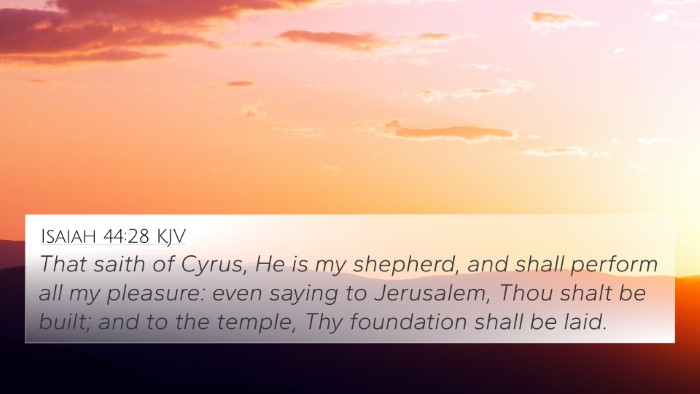
Isaiah 44:28 (KJV) »
That saith of Cyrus, He is my shepherd, and shall perform all my pleasure: even saying to Jerusalem, Thou shalt be built; and to the temple, Thy foundation shall be laid.
Ezra 5:13 Verse Analysis and Similar Verses
Understanding Ezra 5:13
Ezra 5:13 states: "But in the first year of Cyrus the king of Babylon, the same king Cyrus made a decree to build this house of God." This verse plays a significant role in the history of the Jewish people during their return from Babylonian exile. Below we find a comprehensive analysis of this important verse, linking it with various biblical themes and cross-references.
Contextual Background
The Book of Ezra illustrates the return of the Israelites to Jerusalem and the rebuilding of the Temple. Following the destruction of Jerusalem, King Cyrus of Babylon issued a decree allowing the exiled Jews to return home, an act that marked the fulfillment of God's promise to restore His people. Matthews Henry notes the pivotal role of Cyrus, portraying him as an instrument of God's purpose.
Key Themes in Ezra 5:13
- Divine Fulfillment: The decree by Cyrus exemplifies God's sovereignty and faithfulness in fulfilling His promises to Israel.
- Restoration: This verse signals the restoration of worship through the rebuilding of the Temple, emphasizing the importance of communal worship.
- God's Sovereignty over Nations: The actions of a foreign king demonstrate God’s control over history for the sake of His people.
Bible Cross-References
- Isaiah 44:28: "That saith of Cyrus, He is my shepherd, and shall perform all my pleasure..." - This verse directly mentions Cyrus and God's purpose through him.
- Isaiah 45:1: "Thus saith the LORD to his anointed, to Cyrus..." - Further emphasizes God’s choice of Cyrus in the restoration of Israel.
- 2 Chronicles 36:22-23: "Now in the first year of Cyrus king of Persia..." - Provides a parallel narrative about the decree to rebuild the Temple.
- Ezra 1:1-4: This earlier account shares the details of Cyrus’s decree that initiated the return of the exiles.
- Jeremiah 29:10: Prophecy of restoration after seventy years of exile, leading to verses like Ezra 5:13 showcasing its fulfillment.
- Haggai 1:1: Context of the prophetic encouragement during the rebuilding effort initiated by Cyrus’s decree.
- Zechariah 1:16: God's promise to return to Zion and rebuild Jerusalem, tying into the themes of restoration.
- Matthew 1:12: Lists the genealogy linking to the return from Babylon, showing the long-term covenantal relationship between God and His people.
- Acts 7:43-44: Stephen recounts the history of Israel, including the significance of the Temple, reflecting the fulfillment seen in Ezra.
- Revelation 21:22: Indicates a future hope of God's dwelling with man, linking historical restoration to ultimate divine fulfillment.
Interpretative Insights
Albert Barnes elaborates on the significance of Cyrus’s decree, suggesting it serves as a reminder of God’s faithfulness throughout the ages. The king, despite not being a follower of Jehovah, was used by God to fulfill His divine purposes, demonstrating that God's will can be achieved through anyone, regardless of their beliefs.
Adam Clarke emphasizes that the decree was essential not only for the physical rebuilding of the Temple but also for re-establishing the spiritual practices that had been lost during exile. The verse calls attention to the significance of places of worship as central to the community's identity and faith.
Connections Between Biblical Texts
When examining Ezra 5:13, numerous connections between Bible verses emerge:
- Links to prophetic texts such as Isaiah, which foretell the actions of Cyrus.
- Relates to the themes of restoration found in both Jeremiah and Haggai.
- Establishes a typological connection with New Testament teachings regarding God’s ultimate plan for redemption and restoration through Christ.
Thematic Bible Verse Connections
Studying Ezra 5:13 in conjunction with other scriptures enhances our understanding of various themes:
- God's Faithfulness: Seen in the continuity of His promises from the Old into the New Testament.
- Temples and Worship: A recurring theme throughout scripture, culminating in the concept of the body as a temple in the New Testament.
- Divine Providence: The orchestration of historical events to fulfill divine purposes as explored within the books of Daniel and Esther.
Conclusion
In summary, Ezra 5:13 provides not only insight into a critical moment in Israel’s history but also a rich tapestry of interconnection with various biblical themes and narratives. As we engage in comparative Bible verse analysis and cross-referencing biblical texts, we deepen our understanding of God’s overarching plan for restoration and redemption. Through tools like a bible concordance and bible cross-reference guide, believers can explore these connections and strengthen their faith.
